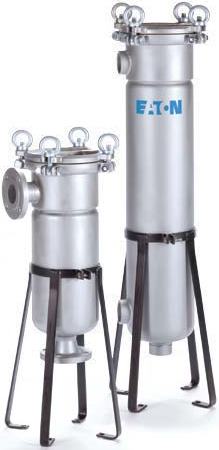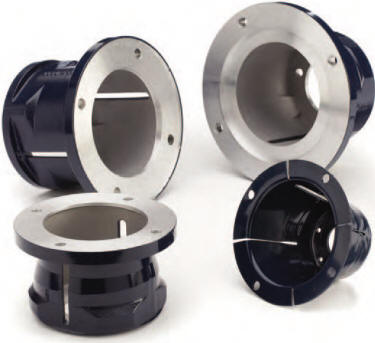Hydra-Cell High Pressure Coolant Pump Skid Design
The sealless design of Hydra-Cell pumps excel at reliably pumping reclaimed machine tool coolant at high pressures. Whereas multistage centrifugal and piston pumps have dynamic seals that must be protected by fine filtration and are expensive to replace, Hydra-Cell pumps do not have cups, packing or mechanical seals which leak and require replacement. Many CNC machinery builders and aftermarket suppliers standardize on Hydra-Cell Pumps due to their reliability and low maintenance design. This article describes the basic components of a high-pressure coolant pump skid and benefits to replacing low pressure centrifugal pumps or troublesome high pressure piston pumps with Hydra-Cell Pumps.
Application Overview
The purpose of metal working lubricants is to cool and lubricate the interface of the tool and product as well as to flush away the cut material so that it is not re-cut. When coolant is applied at high velocity (high pressure) cutting tools can operate faster and with less wear. Different types of machining applications benefit in different ways from high velocity coolant. When applying coolant through hollow drill bits for drilling operations, high velocity coolant ensures complete ejection of the cut material which in-turn reduces tool deflection, wear and contributes to a better surface finish. Milling applications which use similar tooling benefit primarily from the improved lubrication, cooling and flushing of the work piece interface.
Turning, lathing and grinding applications have coolant applied to the tool interface from one or more external nozzles. The purpose is basically the same, to keep the cuttings from being re-cut (tool wear) and to ensure coolant is being applied between the tool and product.
 Filtration
Filtration
Machining processes result in many fines and their characteristics depend upon the material being worked. Long curly strands of material, little chips and fine powdery particles are all common and some level of filtration is required to recycle the coolant and reuse it. Many machining centers are built over coolant sumps which contain baffles to help prevent the larger particles from fouling the pump side of the sump. These sumps are cleaned as needed with our portable pump/filter systems. Sometimes an external holding tank is used and the coolant is transferred from the machining center sump through a #2 size bag filter housing for a finer level of filtration. There is a big difference in filtration requirements when you compare the Hydra-Cell Pump to a centrifugal or piston/plunger style pump which have dynamic seals. The instruction manuals for those pumps will often recommend filtering the coolant to 20 or 25 microns to reduce seal wear. This is not an issue for Hydra-Cell Pumps as they have no dynamic seals and their check valves can handle solids up to 0.03125” (794 microns) and therefore a coarser (less expensive) filter media can be used. While there are system components such as rotary unions and tooling with fine orifices which may require finer filtration, generally speaking those components do not require fine filtration that piston and multistage centrifugal pumps do.
Years ago, I spoke with an enthusiastic supporter of Hydra-Cell Pumps from Hangsterfers Laboratories, a manufacturer of metal working lubricants. He commented to me that some of their high-performance coolants have additives larger than 25 microns and thus such coolant is actually stripped of the very additives that otherwise would help it perform better if filtered as fine as “recommended” by centrifugal and piston pump manufacturers.
Ideally one would use a less expensive 100- or 200-micron filter bag for coolant filtration or perhaps use a mesh lined basket that can be periodically washed and never need replacement.
 Hydra-Cell
Pump
Hydra-Cell
Pump
While there are many capacity and pressure capabilities amongst the Hydra-Cell Pump product line, three pump models and two variations of them satisfy most machine tool coolant pumping applications.
The most common model is the D/G10 series. The D is used to signify the ports are NPT threaded and G is used in the part number when BSPT ports are required. Pumps for coolant applications are typically built with nickel-plated cast-iron pump heads, FKM (Viton) elastomers, and stainless-steel alloy check valves which also contain a celcon valve spring retainer. Hydra-Cell pumps are shipped with Hydra-Oil, which is a quality synthetic 10W30 motor oil having some extra additives such as molybdenum to assist with the initial 100-hour break-in period; thereafter it can be replaced with a quality synthetic 10W30 motor oil such as Mobil 1. Refer to our article Hydra-Oil: role and importance of oil used in Hydra-Cell pumps for additional information.
The D/G10 Hydra-Cell pump is most commonly used to deliver 5.75 GPM at pressures from 30 to 1000 PSI although it is capable of flow rates up to 8.8 GPM. Since positive displacement pumps only displace flow (the pressure is the restriction to flow), one needs to determine the flow rate for their largest tool to achieve the desired pressure. The tooling supplier can advise this information to ensure your pump is sized properly.
 The
D/G10 Hydra-Cell pump is configured horizontally which means the pump is
mounted on top of the machining center sump or alongside of it. The D/G12
variation is a vertical design meant to replace an existing vertically
oriented centrifugal pump with the entire head of the Hydra-Cell Pump
submerged in the coolant tank/sump.
The
D/G10 Hydra-Cell pump is configured horizontally which means the pump is
mounted on top of the machining center sump or alongside of it. The D/G12
variation is a vertical design meant to replace an existing vertically
oriented centrifugal pump with the entire head of the Hydra-Cell Pump
submerged in the coolant tank/sump.
If the application requires pressures within the 1000 to 2500 PSI range, a model D/G15 is used and its vertical version is the D/G17.Lathing and grinding tool unloading applications typically require less coolant and thus the D/G03 size pumps are used; these flow up to 3 GPM at pressures up to 1200 PSI. While there is no vertical version of this pump, there is a high-pressure version for 1000 to 2500 PSI, the model D/G04.
 Pump
Motor
Pump
Motor
The specification sheet for each pump also provides the
formula to calculate the motor horsepower required for your flow rate and
pressure. The motors provided by the factory tend to be TECO Westinghouse
brand, although we provide itemized proposals which would make it easy to
find an equivalent motor locally and probably for less cost.
Some machining applications are pump/motor noise sensitive; as an example, medical implant manufacturers often have visitors tour their facility or there might be personnel nearby which would benefit from minimal noise. The pump/motor combination will result in about 93 dBa within 1m from the pump/motor skid in most situations. This can be reduced somewhat when operating the pump at a lower RPM or if installed within an acoustical enclosure.
 Pump/Motor
Adapter
Pump/Motor
Adapter
This helpful accessory serves the purpose of ensuring perfect pump/motor shaft alignment. If you do not use a pump/motor adapter then you need to design a pump/motor baseplate which will align the pump and motor shafts such that the center of both shafts are lined-up. This accessory makes it really easy to mount the pump to the motor and since both the pump and motor have mounting feet of their own, you do not necessarily require a baseplate assembly. Our itemized proposal describes the coupling required so you have the option of sourcing it locally and it’s the same with the baseplate, if you need one you might consider fabricating a simple design since the pump/motor adapter takes care of the alignment aspect.
The shaft coupling connects the pump and motor shaft together, which are usually different diameters, so the description might be M28 Shaft Coupling with Sleeve, 7/8" x 1-1/8” where the pump shaft diameter is 7/8” and the motor shaft diameter is 1-1/8”.

Baseplate
The factory supplied baseplate has a ergonomic design which allows all fastening to be done from above because corresponding nuts are welded underneath. Different versions have been designed for various pump models and motor size combinations which greatly simplify assembly/disassembly.


Pressure Regulating Valve
 High pressure coolant pump applications should
incorporate a pressure regulating valve into its design as it protects the
pump from over-pressurization and can be used to limit down-stream pressure
from damaging components. nner Engineering’s PRVs have an extremely
reliable sealless design.
High pressure coolant pump applications should
incorporate a pressure regulating valve into its design as it protects the
pump from over-pressurization and can be used to limit down-stream pressure
from damaging components. nner Engineering’s PRVs have an extremely
reliable sealless design.
Most customers will run their coolant pump continuously and rely on the PRV to divert more or less coolant depending upon the tool being used. If you size the pump to handle the largest flow rate tool, let’s say 5 GPM at 900 PSI and the pump outputs 5.75 GPM, about 0.75 GPM is continuously bypassed to the coolant feed tank and the pressure will remain at 900 PSI. If you switch to a smaller tool, maybe it only requires 3.75 GPM for 900 PSI operation, the PRV simply bypasses 2 GPM and the pressure remains steady at 900 PSI. So as long as you size your pump properly and want to use the same pressure range for all the tools, this approach is very simple and requires no adjustments to the motor speed or setting of the PRV.
Some customers want to minimize the volume of coolant bypassed; maybe they have some very small tools or leave the pump running when no coolant is required. In such cases they can incorporate a variable frequency drive into their system which enables the operator to control the flow.
Those are the major components of a typical Hydra-Cell high pressure coolant pump skid and this is what the completed assembly looks like:

We can also supply accessories such as the PRV, inlet/outlet pressure gauges and coolant filtration equipment.
We are typically working with companies that have a low-pressure system and want to convert it to higher pressure – so we provide an itemized proposal for the major components required. Our pricing is less expensive then suppliers of high pressure coolant add-on systems, however their designs are often more complex and include items such as a pump/motor acoustical enclosure to reduce the noise level, integration into your specific machinery and they often provide a completely fabricated/engineered system whereas we are essentially providing the major components in support of a DIY approach to upgrading to high pressure coolant.
Please refer to our website https://cnc-coolant-pumps.com/ for detailed specifications of each pump model and keep us in-mind when replacing or adding a new coolant pump for your CNC machine.






